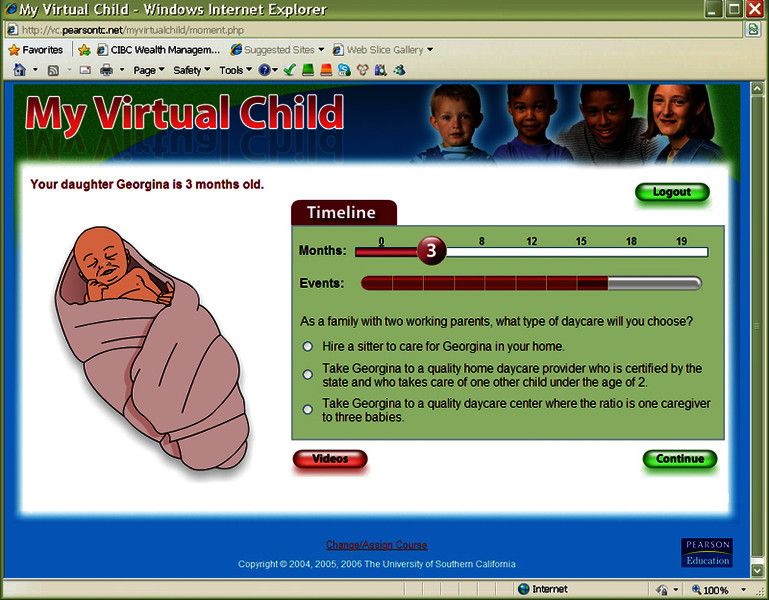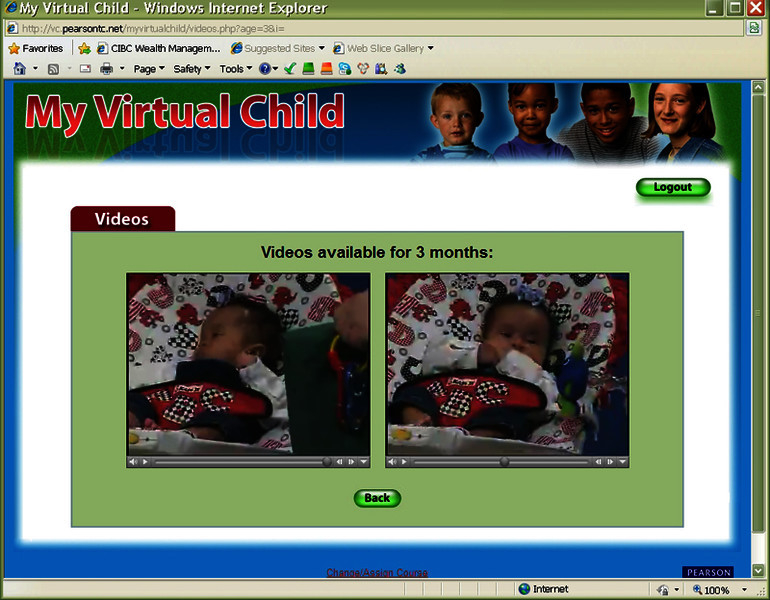Planning Parenthood: Raising a Virtual Child
Most of us embark on parenting with great anticipation and enthusiasm-but little prior knowledge. We learn through trial and error and our children are usually our best teachers. How often have you caught yourself uttering “If only I had known (better), I would have done things (differently)”…
Since January 2009 I have introduced a learning activity known as My Virtual Child into my Child and Adolescent Psychology classes at Champlain College, St. Lambert. My intent is twofold: I want to increase active learning and encourage students to apply concepts to real-life situations. By accessing a web-based interactive program (myvirtualchild.com, part of mydevelopmentlab, available through Pearson Education) each student becomes the proud parent of a virtual child, choosing their gender, name and physical appearance. Over the course of the semester, they raise their child from birth through late adolescence by making decisions about childrearing that appear online, on 293 screens in the program. Students apply course concepts to these decisions which, in turn, shape their child’s emerging personality and unique characteristics.

Example of question
How the program works
When students purchase the course textbook they receive an access code which connects them to the myvirtualchild online program. At birth each virtual child is randomly assigned one of three personality types (over controlled, under controlled or resilient), as well as various intellectual and physical abilities. True to life, the program also includes other random unplanned events such as divorce (affecting 25% of the cases) and ADHD1 (5%). The child’s developmental pathway is determined by these preset variables as well as ongoing decisions the student makes as their child progresses through each age level. … increase active learning and encourage students to apply concepts to real life-situations.Students are advised to “answer the questions the way you think you would act as a real parent”, and they rely on course content and class discussions to inform their choices. Along the way students receive regular reports on their child’s progress from pediatricians, psychologists and teachers. As well, definitions, brief illustrative videos and reflective questions appear at all age levels. The student is even provided with a variety of (standardized) snapshots of their child as they mature. Although the child’s personality and characteristics remain fairly stable through childhood and adolescence, students quickly realize that these variables can be moderated by the decisions they make. This provides a whole new meaning to the nature-nurture debate! Although the student can review their earlier childrearing choices by clicking on a timeline, once a decision has been taken it cannot be undone. The program takes from six to eight hours to complete and it picks up wherever the student left off.
How I use this in my teaching
This semester, along with my students, I am also raising a virtual child:
Georgina was born three weeks premature and is having difficulty with her eating and sleeping patterns.

Video of a 3 month old baby
I often begin class by soliciting collective feedback on issues related to Georgina’s care. In turn, each student will face similar decisions with their own virtual child. I focus short lectures and class discussions on topics (such as attachment or temperament) that I subsequently ask students to report on, in a series of four journals on their virtual child which they submit throughout the semester. Students also participate in two parent forums. In small learning teams each student gets to boast about their virtual child’s progress and accomplishments. They also solicit advice from fellow parents about problems their child may be facing. This feature adds a particularly realistic dimension to their child rearing experience. As the end of the semester approaches, each virtual child has emerged into a unique individual with their own strengths and challenges, ready to embark on college studies or the job market.
Impact on student motivation and future plans
Student response to this learning task has been very positive. The experience of raising a virtual child provides them with the opportunity to apply conceptual knowledge and it enhances their learning. They also walk away from the course with a deep understanding that the decisions parents make about their children WILL have an impact on the child’s later development. This task has become the cornerstone of my Child and Adolescent Psychology course. I plan to continue to use this online tool in my classes and to explore additional ways to enhance its application in my courses.Student response to this learning task has been very positive.
When I solicited student feedback on this experience last semester, one student wrote the following, “I learned that there are no perfect ways to raise a child, and it’s harder than it sounds in theory.” Now don’t you wish you had known that BC (before children). It’s too late AD (after the damage)!
In conclusion, I would recommend myvirtualchild as an excellent learning tool for any courses that involve the study of child and adolescent development. The fact that Pearson Education provides students with access to a help chat line, which they can access 24/7 if they run into technological difficulties with the program, is an added bonus.


What a wonderful tool! I love the idea that although the child is virtual, your real live students are making difficult decisions and discussing their options with their real live peers and teacher. This is not something that is all taking place on the screen; it is extending out into their classroom and on into their own lives. I am sure more than one of them considered their own parents and the decisions they might have made, and many of them will be less likely to judge others in the future now they have experienced (virtually) the complications of raising a child themselves.
I will defiantly share this idea with my social science colleagues! Thanks Susan!
I already paid 163.00 for the book now I have to pay an extra 25.00 out of pocket for the virtual child access code. That’s not right not all students have that type of money i’m going to school on grants and loans now I need a credit card.